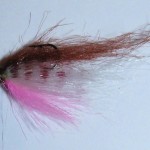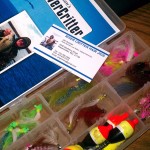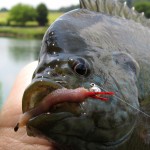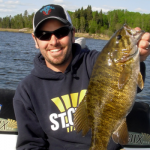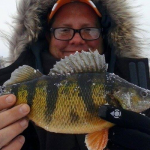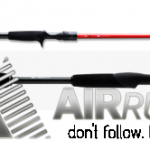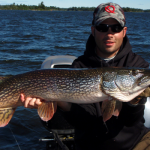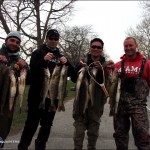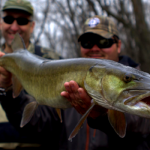By Jim Gronaw
One of the cool things about fishing for panfish with today’s ultra and even micro-light gear is that it makes little fish seem big. This is especially great news for guys like me who catch mostly small fish anyway. Where as 50 years ago the panfisherman was limited to a cane pole and a can of worms, todays panfishers are appropriately suited with a wide range of tiny, sensitive rods and lines that test but even one pound in strength. Lure companies are producing many types and styles of lures specific to bluegill, crappie and perch fishing applications. Plastics have come a long way, as have hair jigs and tiny crankbaits. The fly fisherman was way ahead of the game with the dry fly and nymph patterns for bedding bluegill and such. Not only is this great sport, but it is challenging when larger panfish are in the mix.
If there is a panfish out there that could be considered the strongest or the toughest, I would have to cast my vote for the hybrid sunfish. There are many natural occurring crosses from sunfish species, in many waters. The ‘hybrid sunfish’ that is most written about and stocked to provide quality fishing is the green sunfish/bluegill cross…a lab creation that produces powerful, fast growing offspring that have powerhouse fighting abilities with an attitude. Hybrid sunfish are readily available from many hatcheries and even from Southern States stocking packages for farmponds. They grow quickly, topping out at about 12 inches and can weigh 2 pounds. They are popular for small lake owners who want quality panfishing fast. About 95% of all GSF x BG hybrids are male, which means subsequent reproduction is almost zero. There are male and female hybrid sunfish, with females becoming gravid in the spring, and any offspring from these fish are not as vibrant or durable as the original F-1, or ‘first generation’ hybrids. Stocking of hybrids can work every 5 to 7 years in most scenarios, as older fish become diseased or die off or are caught and harvested for food.
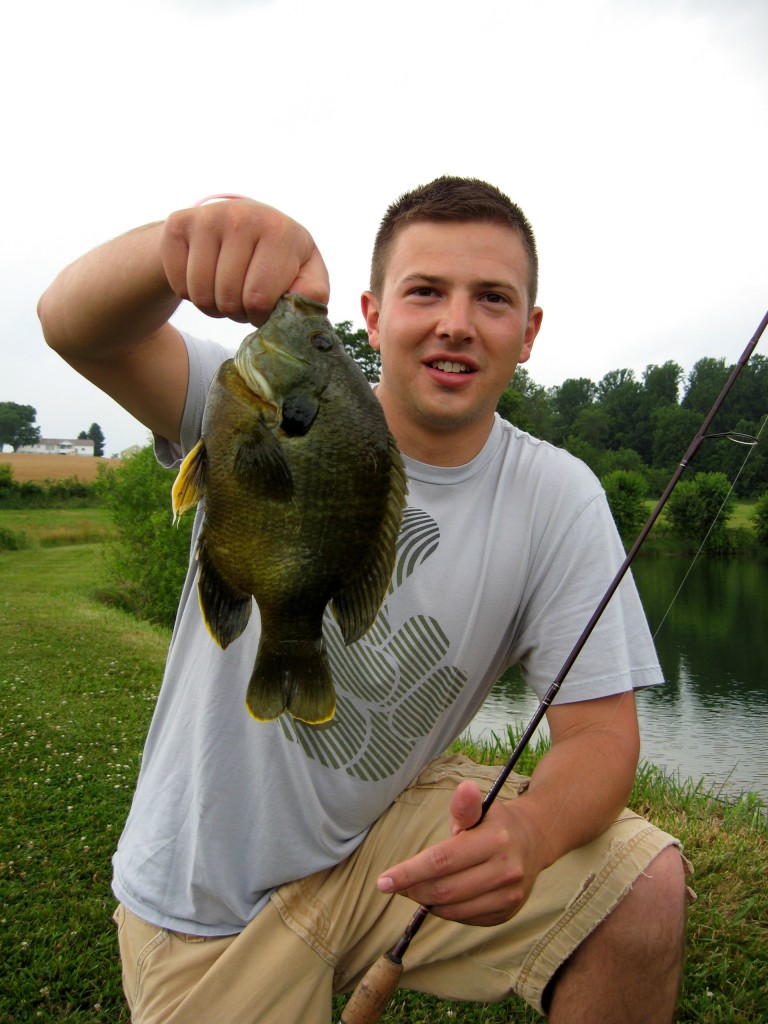
There are several things I like about hybs. For one, they are without question the strongest fighting panfish I have ever caught. Add to that the fact that they have brilliant coloration on their fins and flanks, looking almost as if it were something out of the Amazon. Third, these fish grow monstrous, with 10 to 12 inchers being common in good hybrid ponds. They are viciously aggressive and hit small lures with sledgehammer force and can easily run off 30 feet of drag on the initial run. On 2-pound test line and mini-gear they are a worthy challenge. The only downside to these fish is that most state agencies do not handle them nor do they stock them in public venues. Green sunfish and bluegill waters do overlap, but there is almost zero natural hybridization of these two species in the wild.
My experiences with these fish have occurred in private ponds in the Mason-Dixon area. A recent trip to a hybrid hotspot proved once again as to just how tough these fish are. Using a 1/64th ounce grass shrimp pattern hairjig, I casted around the shady side of a pier and found that the big crossbreeds couldn’t resist. They pounded the jig and streaked off on lengthy runs on 2-pound tackle with brutal surges. Surely, this could not be a ‘panfish’, could it? Naww… had to be at least a 3, maybe a 4, pound largemouth. But soon, a huge wide fish would appear, not that long but built like a Frisbee. Wow! Can I even get my hand around that fish? Is he gonna’ snap my two-pound mono? Check out those colors…amazing!
Another neat thing about the hybrid sunfish is the color schemes and variations on individual fish. Most all will have either orange, yellow or white pectoral fins with bright tips on the spiny dorsal of the same color. Barring is not always apparent. Overall colors can be from dark olive to turquoise to greenish yellow. Fin edging is a common trait, and the orange or yellow crescent on the eartab is also a giveaway. Some big old hybrids just get beat up and look like they have been through a war. Others don’t have a scale missing and are picture-perfect. All of them, to me, are beautiful.
Despite the advantages to the GSF x BG hybrids, some pond owners prefer the common bluegill, as its successful spawning efforts will keep an ongoing food source for any ponds bass or channel catfish population. Most good hybrid ponds have very little else in the terms of other sunfish species, as the feeding aggressiveness of the hybrids just dominates those other species. In time, a pond that is yielding big hybrids will have only small bass, or perhaps a few holdover giant bass that have been in the system for a number of years.
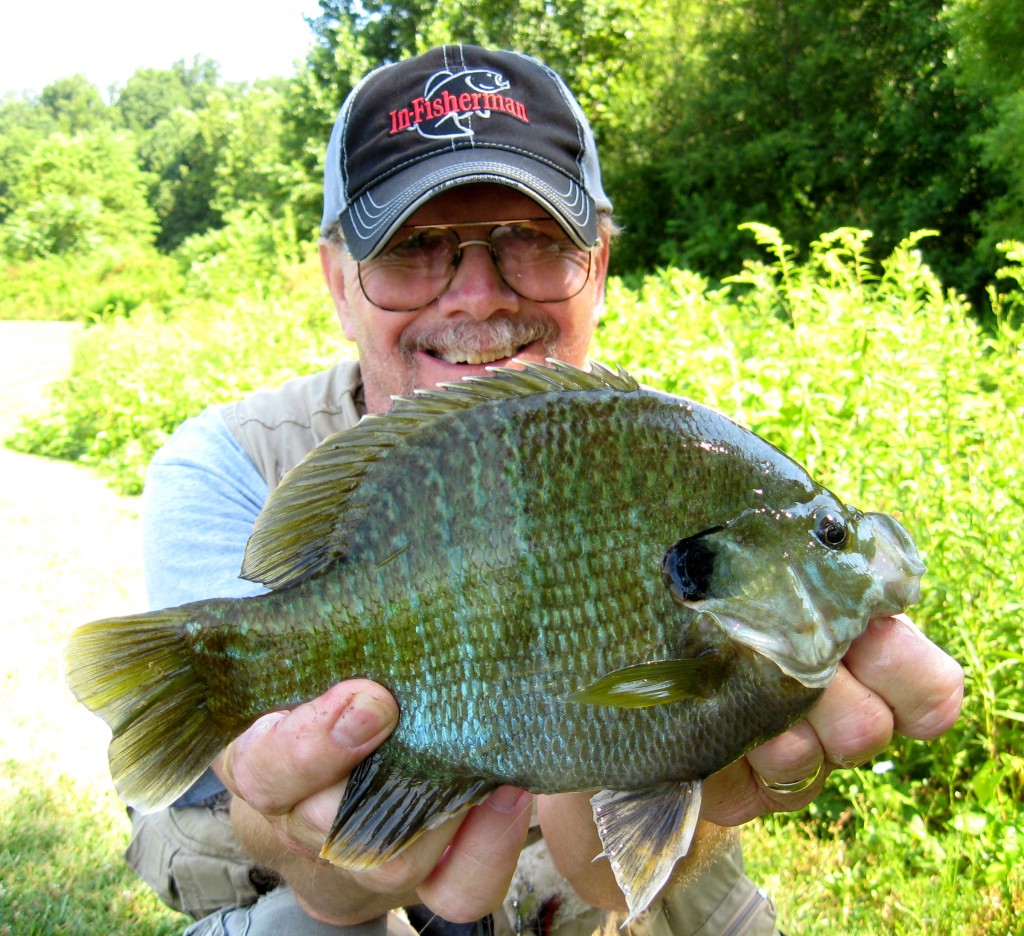
Pond or lake owners wishing to stock their waters with the hybrid sunfish should research the options through various sources on the internet, as not all ponds are good candidates for these fish. No, they won’t overpopulate, but they can overwhelm other species with their nature. They respond well to pellet feeding and can usually attain harvestable size by the 3 or 4 th season in most waters. We have taken them as large as 12- inches long and approaching the 2 –pound mark. Again, they get my vote as the baddest panfish that swims. For more information click on Bob Lusk’s pondboss.com or contact local hatcheries that may supply them. Who knows…you might be doing battle with a huge sunfish sooner than you think!



